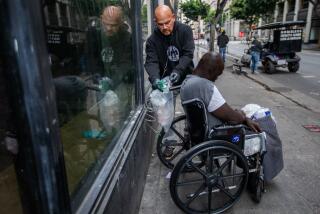Defibrillators at Your Fingertips
- Share via
A national effort to make defibrillator training as commonplace as CPR instruction is slowly gaining steam as the lifesaving devices show up in malls, theme parks, casinos, senior centers, golf courses and schools.
New sophisticated devices have become so easy to use that a pair of 11-year-olds at Nimitz Middle School in East Los Angeles recently shocked a stalled heart back into normal rhythm in 63 seconds after just a single hour of training. Although the demonstration was performed on a mannequin rather than an actual human being, the students revived the “patient” faster than the average time it takes paramedics when they use defibrillators on a dummy.
By next year, all federal buildings and all domestic flights in the United States will be required to have defibrillators available.
The campaign to locate defibrillators in public places and equip public safety personnel with the devices is a joint effort of the American Heart Assn., the American Red Cross, emergency physicians and emergency services agencies. Their collective goal: to improve the survival rate of patients who collapse from cardiac arrest. If training can be made easier and more available, these groups aim to reduce a cardiac arrest death rate that has remained virtually unchanged in 20 years.
Sudden cardiac arrest, where the heart begins to beat erratically--twitching and quivering without pumping blood--kills more than 220,000 Americans each year, making it the nation’s leading cause of death. Only about 5% of those who suffer cardiac arrest survive, although trials at O’Hare Airport in Chicago and at Las Vegas casinos have shown dramatic improvements when defibrillators are available. Unlike heart attacks, in which part of the heart muscle dies but the patient is usually conscious, cardiac arrest leaves a victim looking lifeless, with no pulse and no breathing.
Eighty-five percent of cardiac arrests occur in the home and can strike people of any age, although the attacks are most likely in older people. Those most likely to be called on to assist are the victim’s spouse or someone else living in their home.
A study in the September issue of the journal Annals of Emergency Medicine analyzed how quickly and accurately 105 older couples from the Seattle area did after receiving instruction through a video or a teacher. Both groups performed well after learning either training method, although the video learners had a slight edge.
“It’s easy to train anybody--old, young, whatever educational level,” said Hendrika Meischke, the study’s lead author and an associate professor at the University of Washington in Seattle. “What’s more difficult, particularly with an older group, is maintaining their skills over time.”
So far, the majority of people trained to provide CPR and use a defibrillator have been younger people, but experts hope to make training available to the broader population.
“The potential is clearly limitless,” said Dr. Vinay Nadkarni, chairman of the American Heart Assn.’s emergency cardiac care committee. “The proportion of the population that is currently trained is just the tip of the iceberg.”
Several experts agreed it’s easier to teach seniors how to use defibrillators than to administer CPR. At any age, people have fewer fears about using defibrillators, said Dr. Marc Eckstein, medical director for the Los Angeles Fire Department, because there’s no risk of disease transmission as in mouth-to-mouth resuscitation, and they barely touch the patient. “People who want to perform CPR may be fearful they won’t perform it correctly,” he said. “With this machine, if you remember how to turn it on and remember the concept, the machine won’t allow you to screw up.”
A portable defibrillator, about the size of a notebook-computer, weighs from 4 to 7 pounds and costs about $3,500. The devices are virtually foolproof: They’re programmed to jolt only hearts that need it. (So a child couldn’t, for example, zap the family pet with the device.) A recorded voice prompts the rescuer to stand back and hit the shock button. Even if the rescuer were to touch the patient, any electric shock that he or she would receive probably wouldn’t be harmful, Nadkarni said.
The ideal time to intervene during cardiac arrest is within the first five minutes. For every minute of delay, a person’s chance of survival drops 10%. It often takes seven to nine minutes for paramedics to arrive, and that’s usually too late.
Currently, a doctor’s prescription is required to purchase a defibrillator for home use. However, few cardiologists have prescribed them so far. Some experts expect home use will grow if prices drop and health insurers reimburse patients for the devices.
Eckstein is working to get about 100 of the devices installed at Los Angeles International Airport terminals and in city buildings. Within five years, he predicts, “We’ll start seeing these like fire extinguishers.”






